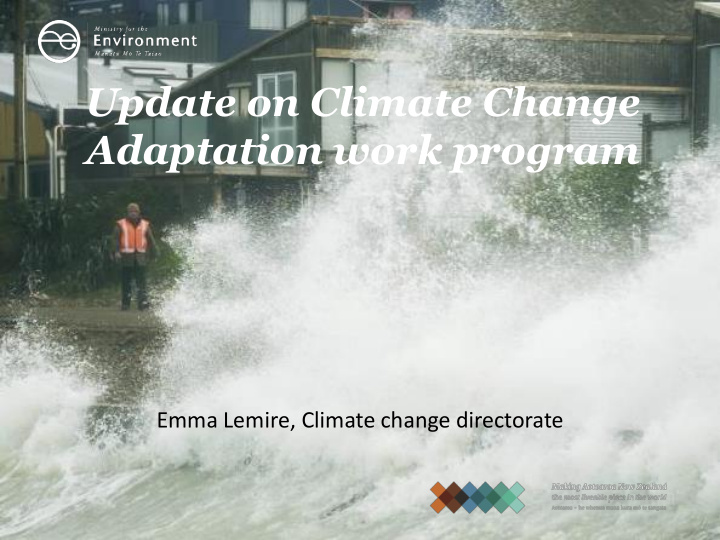



Update on Climate Change Adaptation work program Emma Lemire, Climate change directorate
Presentation title here Climate Change Adaptation Technical Working Group • In November 2016 Minister Bennett established a Climate Change Adaptation Technical Working Group comprising technical experts across government and the private sector. • The Group will provide advice on options for adapting to the effects of climate change. Their advice will be based on sound evidence, starting with a stocktake of existing adaptation work across central and local government and the private sector.
Presentation title here Climate Change Adaptation Technical Working Group • To complete the stocktake report, questionnaires were sent out to all local authorities and central government agencies. • The aim of these was to get a picture of what work each sector is currently doing on climate change adaptation, and what they see as the gaps and barriers to further action.
Presentation title here Key Findings: Central Government • Central government has focused on providing information and some national direction. • Importance of considering climate change in decision- making referenced in multiple central government strategies/frameworks. But few provide details on how they will do this or are formally monitored. • A consistent theme across all agencies is the importance of building long term ‘resilience’. • Currently a lot of policy work focused on natural hazards and risks. • Some government activities could increase our future vulnerability.
Presentation title here Gaps: Central Government • Cross-sectoral adaptation leadership. • Integrated systems approach to climate change policy. • Enablers to support local implementation, such as funding for proactive planning. • Monitoring and evaluation of current measures in place. • Capacity and capability.
Presentation title here Key Findings: Local Government • Adaptive capacity of many councils is limited by the legacy of past infrastructure and planning decisions. • Cost of adapting to climate change a serious issue requiring greater resourcing and new policy approaches. • Councils are taking incremental steps towards adapting to climate change. • The extent and scope of action varies considerably. Councils are at different stages of planning, have different views on how to manage climate-risks and have different needs. • Many councils realise the importance of adaptation and would like to do more but face constraints.
Presentation title here Gaps: Local Government • Central government leadership and support. • Capacity and capability, including funding and information constraints. • Coherence across legislation and action. • Community understanding and buy-in on the need to act on climate change impacts now.
Presentation title here Coastal Hazards and Climate Change Third edition • Guidance supports councils to manage and adapt to the increased coastal hazard risks posed by climate change and sea-level rise. • The guidance does not prescribe a single value of sea- level rise to plan for, but recommends a risk-based approach (considering a range of values). • Planning using a range of scenarios is recommended, with the level to plan for depending on the time frame in question and the type of assets at risk.
Presentation title here Coastal Hazards and Climate Change Third edition • Guidance has been updated to include the latest science and legislation as well as the PCE’s 2015 report on sea level rise and feedback from stakeholders. • There is substantial new content on: • Risk assessment • Community engagement • Adaptive planning • It outlines a ten-step decision-making process that councils and communities can follow when planning for the effects of climate change on coastal hazards.
Presentation title here The 10-step decision cycle
Presentation title here Four scenarios based on global SLR
Presentation title here Appropriate allowances for SLR
Presentation title here Adaptive pathways planning approach • 2008 edition has an emphasis on the technical nature of coastal hazards, new edition contains more material on the planning process. • The guidance recommends a new “pathways” approach to adaptive planning that is dynamic and flexible. • Approach involves developing a series of actions over time (pathways) to achieve objectives under uncertain and changing conditions.
Presentation title here Adaptive pathways planning approach
Presentation title here State of play • As well a substantial technical manual, there is a 35- page non-technical summary and seven fact sheets. • Drafts have had wide review by local government, sector experts and community groups. • The updated guidance is most of the way through the publication process and we are working out a release date with Ministers.
Presentation title here What’s next? • After publication, the guidance will be promoted to councils and communities. • The guidance will be a ‘living document’ – reviewed every year. • MfE has coordinated the production of this guidance with DoC’s guidance on Policies 24-27 of the NZCPS 2010, to ensure that the documents complement each other. • a National Policy Statement on managing risk from natural hazards has been proposed for 2018.
Presentation title here What’s next? • After publication, the guidance will be promoted to councils and communities • The guidance will be a ‘living document’ – reviewed every year • MfE has coordinated the production of this guidance with DoC’s guidance on Policies 24-27 of the NZCPS 2010, to ensure that the documents complement each other • a National Policy Statement on managing risk from natural hazards has been proposed for 2018.
Recommend
More recommend